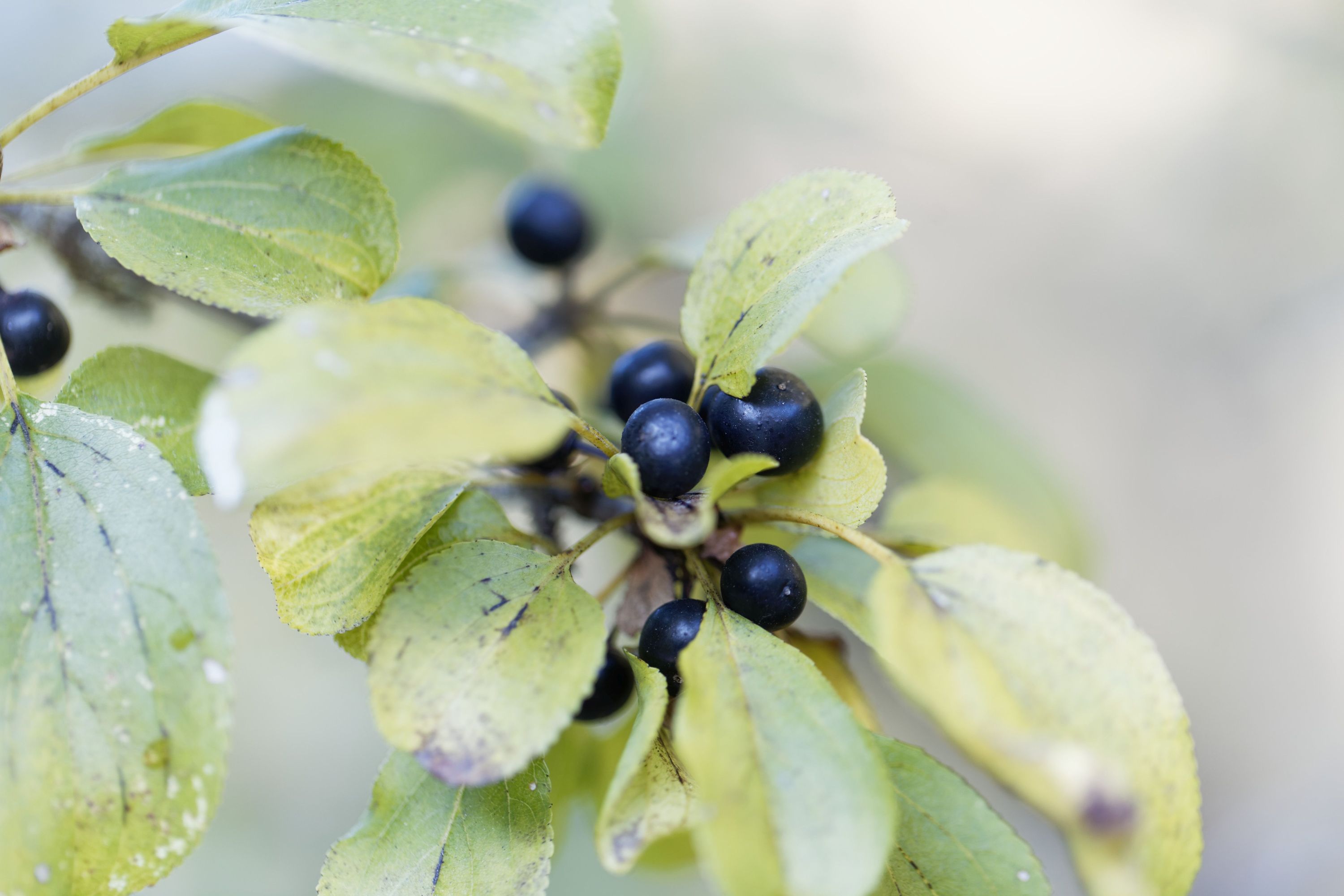Common buckthorn
(Rhamnus cathartica)

Description
Common buckthorn (Rhamnus cathartica) is a shrub or small tree native to Europe, North Africa, and Asia. It was introduced to North America in the 19th century as an ornamental plant and has since become a widely distributed invasive species in many regions. Despite its attractive appearance, common buckthorn can cause ecological harm and is considered a noxious weed in many states. Description Common buckthorn (Rhamnus cathartica) is a shrub or small tree that typically grows to a height of 10 to 25 feet (3 to 8 meters), but can reach up to 30 feet (9 meters) under ideal conditions. The plant has a dense, spreading crown with dark green, glossy leaves that are oval-shaped with finely toothed edges. The leaves are arranged alternately along the stem and are 1 to 3 inches (2.5 to 7.5 cm) long. The flowers of common buckthorn are small, greenish-yellow, and inconspicuous. They appear in early summer, usually around June, and are followed by clusters of small, green berries that turn black as they ripen in the fall. The berries are about 1/4 inch (0.6 cm) in diameter and contain several seeds. The bark of common buckthorn is grayish-brown with prominent, raised lenticels. Overall, common buckthorn has an attractive appearance, which is why it was originally introduced as an ornamental plant. However, due to its invasive nature and negative ecological impacts, it is now considered a noxious weed in many regions. Habitat and Distribution Common buckthorn (Rhamnus cathartica) is native to Europe, North Africa, and Asia, but has been introduced to many parts of North America as an ornamental plant. It is now considered an invasive species in many states, including Minnesota, Wisconsin, and Illinois. Common buckthorn can grow in a wide range of soil types, but prefers moist, well-drained soils. It can tolerate shade and is often found in forest understories, but also thrives in open fields, roadsides, and disturbed areas. In its native range, common buckthorn is found in woodlands, hedgerows, and scrublands. It is also commonly cultivated as an ornamental plant. In its introduced range, it has become naturalized in a variety of habitats, including woodlands, grasslands, wetlands, and disturbed areas. It is particularly common along forest edges and in open fields, where it can form dense thickets that outcompete native vegetation. Ecological Impacts Common buckthorn (Rhamnus cathartica) is a highly invasive species that can have significant ecological impacts. Some of the main impacts of common buckthorn include: Reduction of biodiversity: Common buckthorn can form dense thickets that shade out native vegetation, reducing biodiversity and altering ecosystem function. Changes in soil chemistry: Common buckthorn can alter soil chemistry, reducing soil fertility and making it more difficult for other plants to grow. Spread of non-native plants: Common buckthorn can create gaps in the forest canopy, which can promote the growth of other invasive plants. Alteration of wildlife habitat: Common buckthorn can provide habitat for invasive species, such as European starlings, which can displace native birds and other wildlife. Disruption of ecosystem function: The invasion of common buckthorn can alter nutrient cycling and other important ecosystem processes, which can have cascading effects on other organisms in the ecosystem. Economic impacts: Common buckthorn can also have economic impacts, particularly on agricultural crops. It is known to host the soybean aphid, a pest that can cause significant damage to soybean crops. Overall, the ecological impacts of common buckthorn can be significant, and control measures are necessary to prevent further spread and restore native ecosystems. Control and Management Due to its aggressive growth and ecological impacts, common buckthorn is considered a noxious weed in many states and is subject to control measures. Mechanical control methods, such as cutting or pulling, can be effective for small infestations, but may be labor-intensive for larger areas. Chemical control methods, such as the use of herbicides, can be effective for larger infestations, but care must be taken to avoid damage to non-target species. Biological control methods, such as the use of insects or pathogens that target common buckthorn specifically, are also being developed and studied as potential long-term solutions. Conclusion Common buckthorn is a highly invasive species that can have significant ecological impacts. It has spread widely throughout North America and is considered a noxious weed in many states. Control measures are necessary to prevent further spread and restore native ecosystems. As with any invasive species, early detection and rapid response are critical for effective control.
Taxonomic tree:







